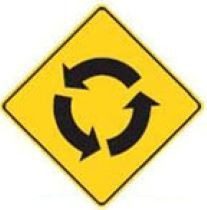by Brandon Mayer, Local Journalism Initiative Reporter
The World Economic Forum did a study on the 256 roundabouts in Indiana. This study was conducted from 2016 to the present, and has shown that roundabouts have reduced traffic deaths by 90% and reduced injuries by traffic accidents by 76%. Additionally, each roundabout saves $5,000 per year compared to intersections with lights. Based on this, roundabouts should be used instead of intersections, provided that drivers take the time to learn how to use them.
A social media storm erupted on Facebook recently, after a local resident posted a complaint about others not knowing how to use a roundabout. Other internet users voiced their own strong opinions, culminating in a full-scale debate, with dozens of comments, attempting to unravel the mystery of roundabout rules. The Times could no longer locate the original post of November 25, suggesting that it was deleted.
On November 24, a follow-up post was put on Facebook by a different resident, this one including a picture of the provincial guidelines for using a roundabout. Just like the original post, a debate soon started, with 66 comments posted as of November 25. Arguments ranged in character from civil to nasty, and focused on aspects of using a roundabout, such as using a turn signal, keeping a safe flow of traffic, and judging what a “safe gap” means when it comes to entering the roundabout.
Given the importance of knowing roundabout rules for drivers to be able to use the road safely, a brief explanation follows for some of these rules which appear on the Ontario website at http://www.mto.gov.on.ca/english/ontario-511/roundabouts.shtml.
“Use the correct lane for your intended destination.” The eastern-most roundabout on Kemptville’s stretch of County Road 43, for example, has two lanes, which seems to be a source of confusion amongst social media users. This is perhaps because a driver’s intention will always be to exit a roundabout at some point after entering it, making the right lane always seem like the best choice. The actual recommendation is to use the right lane when intending to use the first exit, the right or left lane if intending to use the second exit (which is akin to “going straight”), and the left lane if intending to use the third exit.
“Stop if there are already vehicles inside the roundabout.” This is the whole essence of how a roundabout works. Cars already in the circle have the right of way, cars entering the circle must yield the right of way and only enter when the way is clear. However, one important thing to remember is that cars entering the circle are required to yield, which does not necessarily mean stop. If there are no cars coming, traffic can continue to flow into the roundabout at a steady speed of about 30 kilometres per hour. A roundabout does not work like a four-way stop.
“Enter when there is a safe gap in traffic.” This requires judgement on the part of the driver, but, generally, it means only entering when this will not cause another driver to have to react. For example, it is safe to enter a roundabout if there is enough of a gap that another driver will not have to brake to avoid you.
“Don’t stop inside the roundabout, except to avoid a collision.” This is important, because drivers in the roundabout are expecting a steady flow of traffic, since cars already inside the roundabout have a continuous right of way. There is no need to stop once inside the roundabout (except to avoid a collision), because drivers attempting to enter must yield to you.
“Use your right turn signal” (to exit). Failing to signal an exit from a roundabout is not likely to cause an accident, since it will simply make traffic wait for you instead of proceeding. However, it can often cause a congestion problem, since it causes other drivers to wait unnecessarily when they could have entered the roundabout if they knew you were exiting.
Knowing the roundabout rules, and all driving rules, is important because traffic offences carry an absolute liability for those who break them. In other words, penalties apply even for those who were ignorant of the rules, and those who never intended to break them. Knowing the rules of the road will help prevent driving from becoming more costly than it already is!


